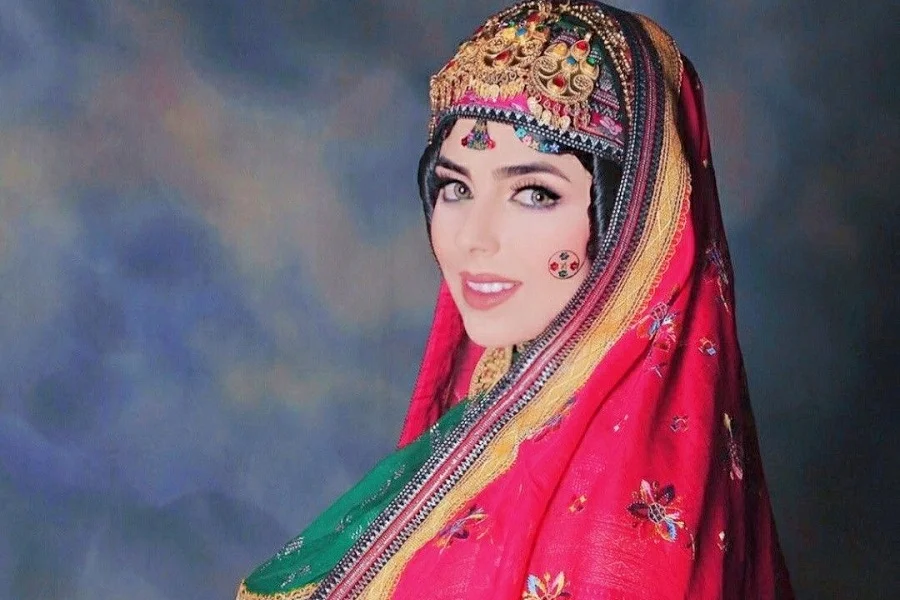
15 Breathtaking Examples of Traditional Iranian Clothing
Iran is a diverse country, with Persians making up the majority of the population, but many other ethnic groups call it home, each with its own unique language, customs, and traditional clothing. In this overview, we explore the traditional attire of some of Iran’s most distinctive tribes, highlighting a rich variety of styles. From creatively designed caps and headdresses meant to confuse invaders, to vibrant color combinations that could easily belong on a fashion runway, Iran’s traditional clothing showcases an incredible cultural range.
Iran’s Traditional Clothing: A Look into the Country’s Rich Culture and History
Clothing has long held a significant place in Iranian culture, particularly in rural regions where traditions and religious values run deep. From ancient times to today, traditional attire remains a key element of life for various ethnic groups, each showcasing the unique customs of their region. Despite the dress code introduced after the revolution, a variety of clothing styles can still be seen, particularly in villages.
Additionally, many women in major cities like Tehran embrace fashion trends and enjoy wearing stylish, modern clothing. They express their ambitions through their sense of style, seeking to be admired for their beauty and elegance.
Iran’s diverse and multiethnic culture is beautifully reflected in its traditional attire. These clothes not only represent the country’s rich heritage but also showcase the artistic talents of Iranian artisans. Men’s and women’s traditional clothing varies in style and color, often adorned with intricate beadwork, embroidery, and sequins, all crafted with great care. The stunning beauty of traditional Iranian dress continues to attract travelers from around the world.
Check out these 14 beautiful examples of traditional Iranian clothing
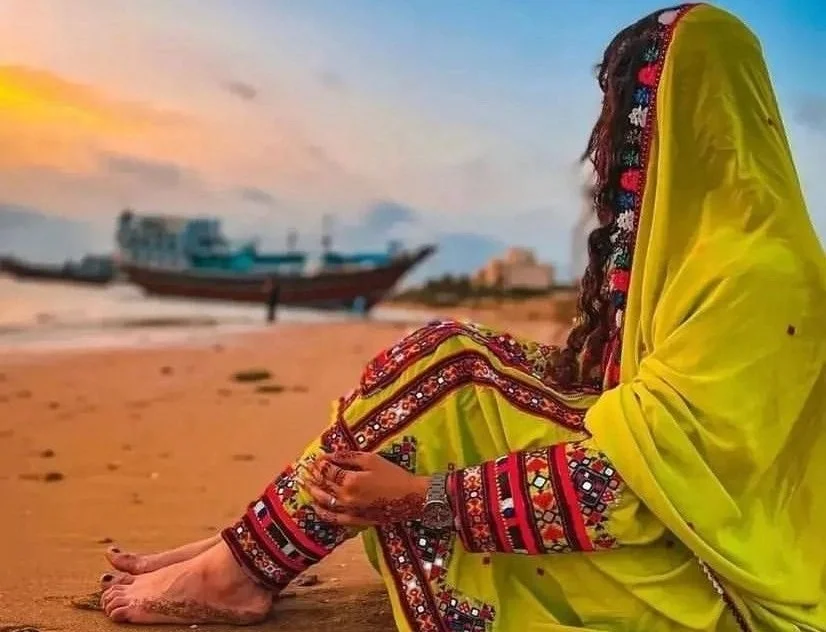
1. Baluchi Cloths: The Traditional Style of Baluchistan
It’s no surprise that the traditional clothing of the Baluch people features the voluminous shalwar kameez—loose pants paired with a long shirt or tunic—since they hail from the southeastern Sistan and Baluchestan region, sharing cultural ties with Pakistan and Afghanistan.
Women typically wear wide-legged pants paired with colorful, embroidered knee-length gowns, adorned with gold bangles, necklaces, and brooches. They often cover their head and shoulders with a longer shawl. For men, traditional attire includes a turban, long trousers, and loose-fitting shirts
2. Gilan Fashion: A Bright and Cheerful Style from the Caspian Coast
The Gilak people, native to the northern region of Gilan, are generally not nomadic. Instead, they prefer to engage in agriculture and animal husbandry in the Alborz mountain range and the surrounding plains.
Women’s attire features long pleated shirts layered over black velvet vests adorned with vibrant embroidery, paired with floor-length skirts, differing from the usual wide-legged pants seen in traditional Iranian clothing. In contrast, men’s clothing tends to be more subdued, often in a black-and-white color palette, accented by brightly colored socks or a wide cotton belt.

3. Shiraz Attire: Experience the Timeless Elegance of Traditional Shirazi Dresses
Many believe that only a few Shirazi women create traditional Iranian clothing for the city. Khus, a type of silver-tissue fabric, has led to the establishment of an Indian Khus weaving business in Shiraz. This beautiful material is used to adorn children’s clothing, as well as scarves, hats, and trousers. Among the most recognizable garments in Shiraz is the large Khus scarf worn by women. Additionally, khus weaving plays a significant role in the bride’s attire.
The local men’s clothing in Shiraz includes a long shirt that can be patterned or plain, well-fitted dark pants, and a lightweight silk robe with sleeves. Completing the look is a simple felt hat adorned with a deer horn and a waistband that ties around the shirt, with the robe draping elegantly over it.”
4. Traditional Cloths of Abyaneh: Celebrate the Unique and Distinctive Styles of the Red Village
When you visit the picturesque village of Abyaneh, you can expect to see joyful, vibrant clothing. The residents’ attire showcases a stunning array of colors and patterns that won’t disappoint. In fact, the traditional clothing of Abyaneh is considered one of the most exquisite in Iran and has gained national recognition for its unique characteristics.
In this beautiful community, women never wear black and always sport floral scarves. Abyaneh’s traditional dress is distinct from that of other cities, featuring white base fabrics adorned with colorful floral patterns. They secure their headbands with a knot and wear a red hoodie underneath. For weddings, the hoodies are embellished with silver to add a touch of elegance and luxury.
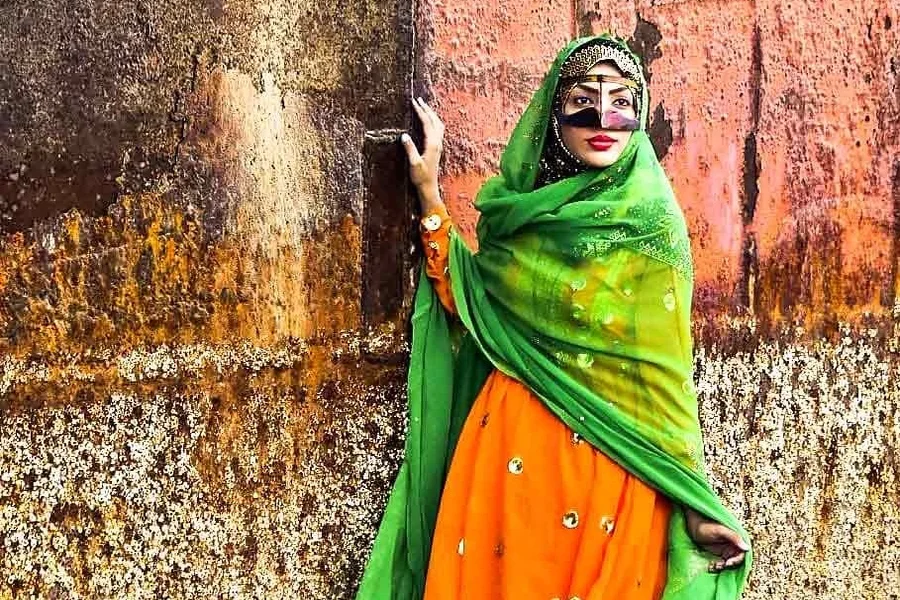
5. Hormozgani Cloths: Bright and Cheerful Styles from the Persian Gulf
This traditional clothing from southern Iran stands out for its clever design, offering protection from the intense sun and heat. Women often choose soft, lightweight fabrics for their garments, and their beautifully embroidered pants showcase their skill and attention to detail.
An intriguing aspect of Hormozgan’s traditional clothing is the ‘Kondero,’ a garment that is also found in parts of southern Italy and Spain, adding an unexpected cultural connection.
6. Kurdish Attire: Traditional and Cultural Clothing from Western Iran
As the indigenous people of Kurdistan—a large region spanning parts of Turkey, Syria, Iraq, and Iran—it’s no surprise that there are regional variations in traditional Kurdish clothing. However, one constant is the preference for loose-fitting clothing with a wide belt to accentuate the waist, worn by both men and women. Men often wear similar coats, while women decorate their headscarves with dangling coins and jewels. Both men and women may also wear black velvet hats adorned with turquoise, amber beads, or silver and gold charms
7. Ilam Clothing: Traditional Outfits from the Land of the Lurs
The key piece of Ilam women’s clothing is the ‘golvani,’ a silk scarf with traditional patterns that carries a touch of Achaemenid influence in its design. In the local language, ‘golvani’ refers to this beautifully designed scarf or head covering. Interestingly, young girls wear smaller versions as scarves, and today, the golvani is considered a cherished symbol of Lorestan.
These styles of clothing were highly popular in the past, especially in this region during the Medes and Achaemenid periods.
Men’s attire also features the ‘kelaw’ and ‘lacheg,’ a square-shaped headpiece made of cotton with geometric patterns. Additionally, the ‘aragchin,’ designed for older men, is commonly worn in Kurdish regions.
8. Azerbaijan Attire: Elegant and Timeless Fashion from Northwest Iran
The traditional Azerbaijani attire reflects the age and marital status of the dancer. While Azerbaijani clothing has modernized and become less common in urban areas since the 20th century, it still retains its significance in nomadic and rural communities, as well as in areas with a high Azerbaijani population.
In this region, women’s clothing is categorized into three types: Sarpush, Tanpush, and Papush. These outfits have a vintage feel, typically featuring a long shirt, a scarf, and a pleated skirt. The most commonly worn garment among Azerbaijani women is the Chadra, a type of veil.
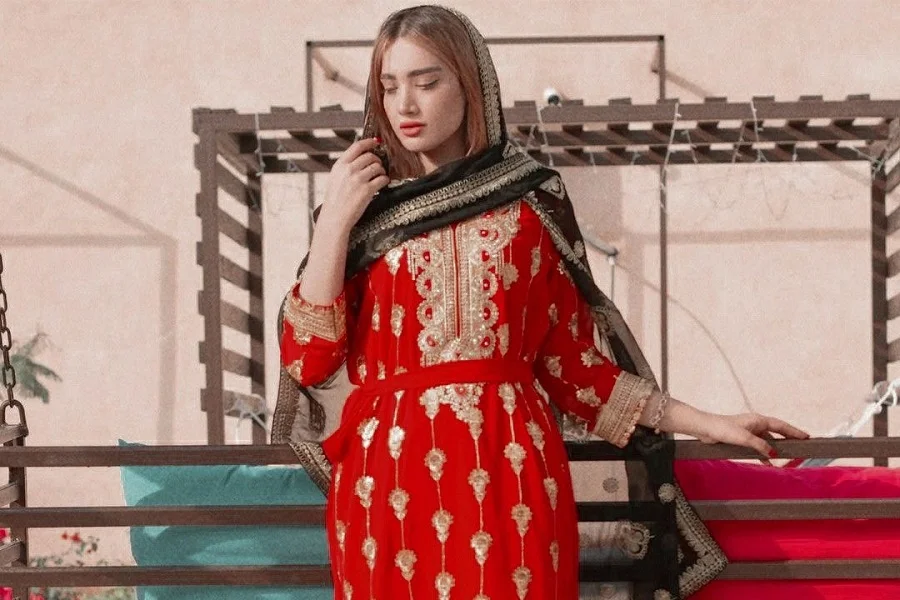
9. Bushehr Attire: Relaxed and Coastal Fashion from the Persian Gulf
While traditional Iranian clothing for women in Bushehr is often dark in color, it boasts many appealing features. Women’s traditional attire in this region includes long, flowing dresses, a lightweight black scarf, a thin face mask, Chit pants, and Kush shoes. This loose-fitting formal attire, also referred to as Arabic dress, is beautifully adorned with delicate embellishments. In Bushehr, it is common for women to keep their faces covered.
10. Bakhtiari Fashion: Sophisticated and Stylish Attire from the Zagros Mountains
The traditional attire of the nomadic Bakhtiari tribe, which migrates from the grassy plains of Khuzestan to the mountainous Chahar Mahal, is designed for adaptability to the harsh climatic conditions they encounter. Women often wear vibrant, layered skirts paired with matching vests, while men typically don tunics and wide pants fastened at the ankles, along with wool skullcaps. Their long head coverings are often embellished with hand-stitched patterns and decorative elements.
11. Qashqai Attire: Vibrant and Bold Costumes from Iran’s Nomadic Tribes
The Qashqai tribe, primarily composed of Turkic, Kurdish, and Arabic ancestry, remains nomadic, with some still following traditional migratory routes. Women are easily recognized by their flowing, multilayered skirts and long headscarves pinned under the chin, allowing their hair to cascade freely and frame their faces. Men typically wear long cloaks with a cummerbund at the waist and collarless white shirts. A notable feature of their attire is the distinctive circular ‘dogushi’ caps, known as ‘two-eared’ caps, made from felt crafted from sheep’s wool
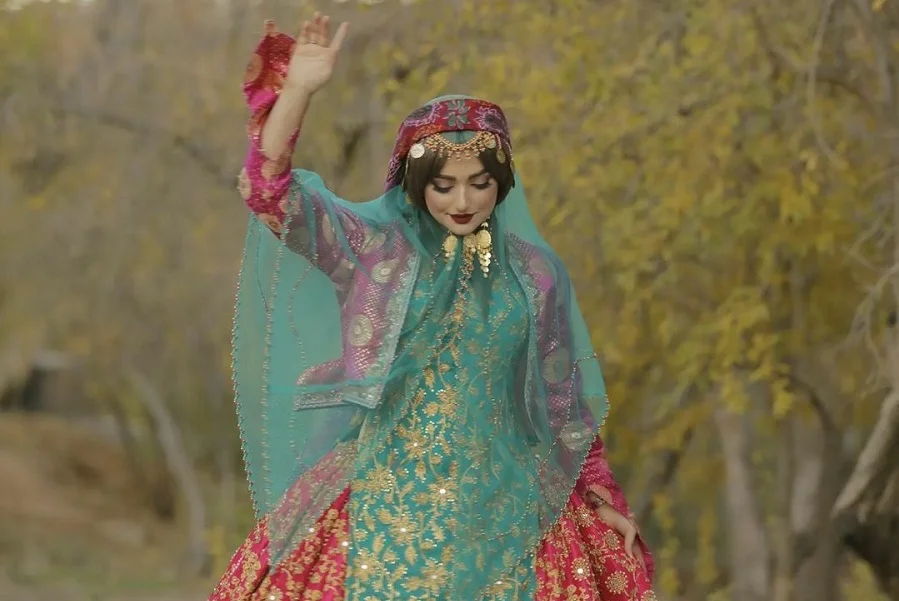
12. Mazandaran Fashion: Exquisite and Lively Attire by the Caspian Sea
The Mazanderani are an Iranian ethnic group native to the Caspian Sea, known for their more understated style compared to some other tribes that favor brighter colors. Women typically wear black pants underneath short, puffy skirts, paired with waist-length tunic tops that are often embroidered with traditional designs. Their headscarves are the most decorative part of their attire, adorned with beads and tassels. Keeping it simple, men usually wear white cotton shirts tucked into hunting pants, topped with a plain vest, and complemented by black socks that reach just below the knee
13. Turkmen Attire: Elaborate and Detailed Clothing from the Turkmen Sahra
The Turkmen are a nomadic group that has lived in northern Iran near the Turkmenistan border for centuries. While some still uphold their nomadic lifestyle, many have settled into permanent homes and tents. Both Turkmen men and women often wear garments in earthy tones. Women typically wear long skirts paired with open robes, often covering part of their faces with a fabric that hangs just below the nose. Men’s attire is primarily marked by wool caps, providing protection against the cold.
14. Lur Fashion: Exceptional and Artistic Garments from Luristan Province
Women in Luristan often prefer vibrant colors, featuring distinctive stripes along the cuffs of their pants. In contrast, Lur men typically favor neutral tones, wearing black felt caps and white shawls wrapped around their waists.
The long part of the headscarf that cascades down the back is typically covered by a vest, which also reveals the sleeves of the long dress worn beneath. The traditional attire of the Lurs stands out for its stunning intricate beadwork, as well as the coins and beads that dangle from their headscarves.
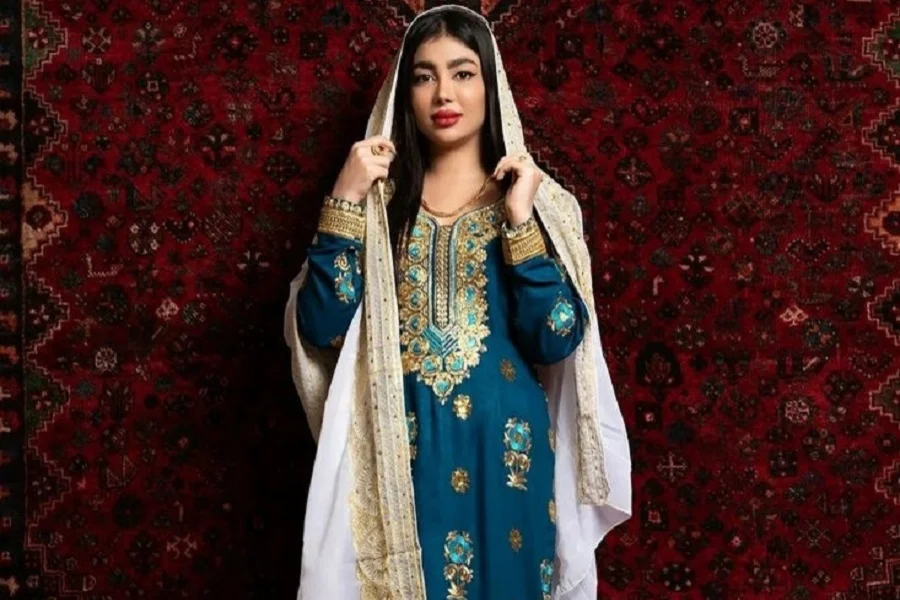
15. Khorasan Fashion: Saffron and Barberry-Inspired Attire!
Khorasan, the vast northeastern province of Iran, is renowned not only for its saffron and barberry exports but also for its rich tradition of local attire. The unique styles found here contribute to the region’s diverse attractions, showcasing the beauty and heritage of Iranian clothing.
The variety of traditional outfits in Khorasan reflects its expansive landscape and the many Iranian ethnic groups that reside there. The province showcases a vibrant mix of tribes, each wearing clothing that resonates with the heritage found in other parts of Iran. This includes tribes like the Turkmen, Kurmanj, and the people of Torbat-e Jam. Notably, the clothing of Khorasan’s Kurdish tribes mirrors the styles of Kurdish communities across the country.
The traditional dress code in North Khorasan embodies not only Islamic ideals but also the region’s unique charm. This charm comes to life through a vibrant array of colors and designs, drawing inspiration from natural beauty. The lively spirit of spring is captured in these garments, with bright, natural hues that evoke a sense of tranquility in those who wear them.
For example, traditional attire for Kermanj women and girls consists of five distinct pieces: the Yashar (or Charqad), a vest, a Shilvar (skirt), a blouse known as the cross, and a shaliteh. Men in the Kurmanj community typically wear Lav and lachg, showcasing bright colors inspired by nature. While these traditional outfits are less commonly seen in urban areas, they still hold significance in certain households, making them a distinctive part of the culture in this region of Iran.
The Turkmen of Maneh and Samolghan, also located in North Khorasan, are dedicated to preserving their traditional attire. They are among the few Iranian ethnic groups that consistently uphold their traditional dress code. The Turkmen primarily utilize fabrics like Kolte, Chelpi, Yelk, and Chavak, often blending in silk and wool. These fabric choices add to the rich diversity of traditional attire found in Khorasan province.
Let us know your opinions in the comments bellow!


Pretty nice post. I just stumbled upon your blog and wanted to say that I have truly enjoyed surfing around your blog posts. In any case I will be subscribing in your rss feed and I am hoping you write once more very soon!